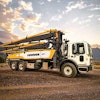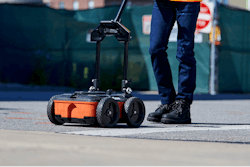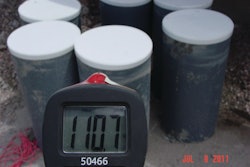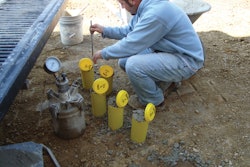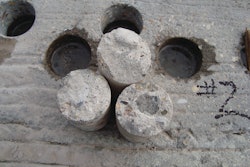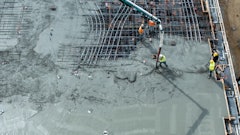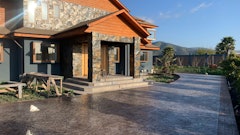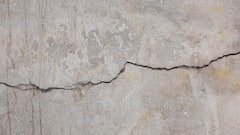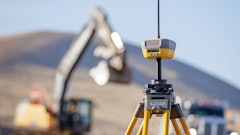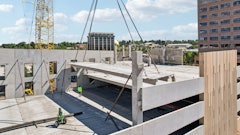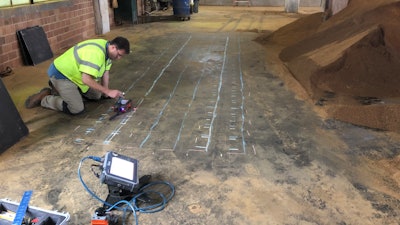
Concrete scanning companies provide imaging solutions to those who need to see inside of existing infrastructure. This work is critical, but the equipment needed can be heavy and tiring to carry around. GSSI's new portable ground penetrating radar (GPR) can help locate rebar, conduits, post-tension cables and voids. It can also help identify structural elements, including pan deck and concrete cover, and provide real-time determination of concrete slab thickness.
One of the best ways to understand a product and its value it to talk to real users. This article offers insights into how and why two professional concrete scanners are using the tool, how they get the most out of it, and their thoughts on new accessories designed to make their jobs easier.
Cobra Cutting Services saves time with portable GPR
Dan Foley is President of Cobra Cutting Services, a full-service concrete sawing and drilling contractor, and Rory Foley is his head GPR technician. The Chicago-area company’s GPR scanning division tends to focus on tough jobs where its attention to safety makes them stand out in the market place. They work primarily with hospitals, wastewater treatment plants and heavy industrial plants, along with institutional facilities like higher education, government and the courts. The Foleys point to the adaptability of the new equipment as a key benefit. “The portability of the GSSI StructureScan Mini XT works well for the situation. It can fit in tight spots, especially those with low clearance. That makes it good for overhead scanning and where pipes are attached to a wall.”
 Shown is a GPR scan of a commercial space. Orange marks indicate the location of post-tension cables and reinforcement.Cobra Concrete Cutting, Chicago
Shown is a GPR scan of a commercial space. Orange marks indicate the location of post-tension cables and reinforcement.Cobra Concrete Cutting, Chicago
He adds that the company is now also using a new miniaturized GPR antenna attachment, the Palm XT, which is especially good for smaller roof sections. “If I’m in a tight spot, maybe only the antenna fits in, or if there’s a little clearance area, I can take the handle off, where most of the larger GPR units wouldn’t fit,” Rory Foley says. Where his team runs into pipes that are tight into the wall, or for areas that have smaller lead-up, they are able to spend less time on the jobsite with the miniaturized antenna attachment and scan an area that might not be possible to hit with full-sized antennas.
Read next: Ground Penetrating Radar Can Save Money and Avoid Hazardous Conditions on Jobsites
The handheld antenna attachment can be used in cross-polarization mode, a method that highlights non-metallic objects, such as PVC, and de-emphasizes metallic objects like rebar and wire mesh. The cross-polarization mode has had a very positive affect on Cobra’s business. Foley explains that the company had previously stayed away from plumbing or electrical trench inspection with the previous generation of handheld scanners because they did not have the ability to cross polarize the antenna. “Now that we can cross polarize the Palm XT antenna, we can interpret data more accurately and distinguish a target from the conduit.”
Another advance is the pole attachment, which Foley uses primarily for scanning trenches. “If I am going to be scanning trenches, I can throw the pole into the truck, and it means I don’t have to crawl on the floor while scanning large areas.” He adds that the equipment is more compact and lighter, which makes a difference for jobs where there are hundreds of feet of trench to scan.
Foley also likes the way he can customize how data is portrayed on the screen, making it easier to interpret. He especially values being able to show the gain in many different ways, make color adjustments, and change the size of the hyperbola, or even view the data in a larger or smaller format.
On the job scans
Cobra has used the new equipment at a number of high-profile jobsites in Chicago, including Trump Tower and Wrigley Field. At Trump Tower, the team used a swing stage to provide information needed for drilling holes through the building’s surface to attach the sign to the building without hitting rebar. Hanging outside of the building with cables about 75 to 100 feet in the air and scanning the vertical surface was a challenge. The portable GPR unit’s small size and safety strap allowed the team to easily and safely mount the individual letters to the building.
 GPR technician marks the concrete reinforcement and utilities in the greater Chicago area using the StructureScan Mini XT.Cobra Concrete Cutting, Chicago
GPR technician marks the concrete reinforcement and utilities in the greater Chicago area using the StructureScan Mini XT.Cobra Concrete Cutting, Chicago
A final example was at a hospital in a southern suburb of Chicago, where a construction team was installing a new plumbing trench in a kitchen where 30 conduits were crossing. Here, the Cobra team used the portable GPR unit with the miniaturized antenna attachment to isolate the conduit and ensure plumbers would miss it where they were crossing the trench.
GPR Engineering increased efficiency and productivity with portable unit
Brad Rister, President of Lexington, KY-based GPR Engineering, uses the new equipment in what he calls a “forensic engineering investigation environment.” To illustrate its importance for this application, Brad cites an example that had a profound effect on his business.
“It was one of those frantic phone calls we all dread,” begins Rister. “One of my friends, who was involved with a hospital construction project, called me at about 7 a.m., asking me to come immediately to the hospital. The owner had chosen not to pay for a concrete scan — and the contractor hit a main electric line right near the six-room operating suite. It all happened just a few minutes before the hospital was due to begin a full day of scheduled cases, as well as keep the OR available for a Helivac situation! When I showed up, a large crew of electricians were desperately trying to piece wires back together. The whole thing was a nightmare, which cost everyone a lot of money.”
Read next: Ground Penetrating Radar is the Key to Concrete Cutting Safety
According to Rister, since then, the hospital requires concrete scanning to be performed before any concrete cutting or drilling work is done. “I think it has taken instances like that to help educate people in the commercial building community in Lexington, to appreciate what scanning can do for you, and what risks it helps you avoid.”
The portable unit is Rister's newest piece of GPR equipment and represents an evolution of the technology that brings much-needed simplification. “It’s the best solution I have seen over the 20 years I’ve been doing GPR. I like the precision, the accuracy of telling you where something is, and the fact that any wheel can trigger the distance measuring instruments (DMI),” said Rister.
Rister also appreciates how lightweight the equipment is. “When you’re scanning overhead, I think it’s the only solution that makes those projects even doable, especially with one person. It helps me cut back on my manpower and employee expense. I can now do a lot of things with one person that previously required two people; one to hold the bulkier equipment and another to use the larger antenna.” This adds up to more staff availability to complete other projects and bring in more work. “I’m not seeing anything drastically different in concrete with the new portable unit than I did with other equipment I’ve used; it’s just much easier to use and to move around. I would probably say it provides a good 25% better efficiency and productivity. And that translates into my bottom line.”
Features make the job easier
Rister also pointed to the extension pole as a life (and knee) saver for performing scans of utility trenches in existing buildings. “It just keeps you off your hands and knees for a good majority of the time.” GPR Engineering frequently works on projects in very large, open and vacant commercial construction spaces, where the customer wants to know the location of pole stitching cables. An easy way to obtain this data is to put the GPR concrete scanning unit on a pole, and walk behind it and look down, as opposed to crawling on hands and knees.
 GPR scan of a commercial space. Red marks indicate the location of post-tension cables.GPR Engineering, Lexington, KY
GPR scan of a commercial space. Red marks indicate the location of post-tension cables.GPR Engineering, Lexington, KY
Finally, Rister points to the usefulness of a new accessory that adds the ability to detect AC power and induced radio frequency (RF) present in conduits. This lets them detect low amplitude AC signals associated with difficult to locate conduits. The accessory can now be used in place of a $7,000 standalone piece of line detection equipment he had purchased years ago. He calls it a “must-have” add-on and advises any new buyers to have one on hand.
Rister has successfully used GPR technology on thousands of road and bridge scans since the 1990s, and has been scanning concrete structures for more than a decade. GPR Engineering has a wide range of GPR equipment to pick and choose from, depending on the specific project. Most recently he has tended to opt primarily for the portable unit. As he explains it, the more compact equipment and improved work flow enables him to be more efficient. “It’s not the only piece of equipment that I go on o jobsites with, but it just happens to be the first one out of the box. It’s the most efficient tool that I have.”
Education needed on benefits of technology
While scanning is becoming more of an industry standard for dealing with concrete slab, both companies agree that more education is needed on its benefits. Dan Foley said that, with the availability of the new technology, the time is right for slab on grade inspection to become mandatory. “It’s good for safety and loss prevention, and I hope the industry embraces it. I believe it should be required on jobsites; and I am hopeful it becomes specified because it avoids so many types of damage both to workers and structures.”
Rister agrees, saying he spends a lot of time educating people on why they need GPR scanning because it is an expense they have not had to incur in the past. He explains it to customers this way, “Doesn’t the expense of hitting something outweigh the much lower cost of finding out in advance what is there — so you can avoid hitting it?” The argument is especially effective for any of his clients that need to have constant power service. For example, he’s seen the chaos created for the retail environment at a local mall when power is knocked out, and has done quite a lot of recent work for malls, hospitals, banks, restaurants and other businesses that simply cannot afford to be knocked offline.
“In my view, the lines you leave on the concrete floor give guidance to the next person. My approach to the jobsite is almost like an operation. Like a surgeon, I’m going to come in and tell you what we are going to cut, and what we’re going to avoid. Or, to give another analogy of how I see the important work we do, think of it like a map, where those X’s on a page represent the buried treasure” said Rister.
Take advantage of training classes to become educated on the benefits of GPR
There are many ways to become educated on the benefits of GPR technology. Many manufacturers provide theoretical and instructional classes for GPR technicians. For example, Geophysical Survey Systems, Inc (GSSI) offered more than 130 classes GPR instructional classes in 2018. In addition, several industry associations now offer industry-specific training. Examples include the Concrete Sawing and Drilling Association (CSDA), which has held classes at the World of Concrete conference and offers GPR certification for technicians with more than two years field experience; as well as he National Utility Locating Contractors Association (NULCA), which provides utility locating accreditation.



